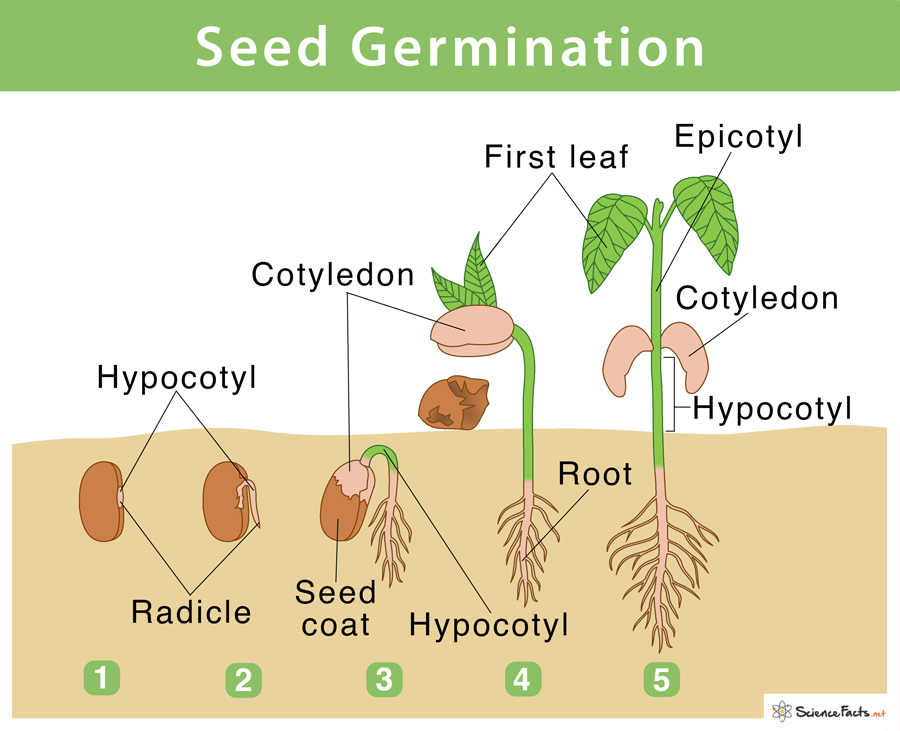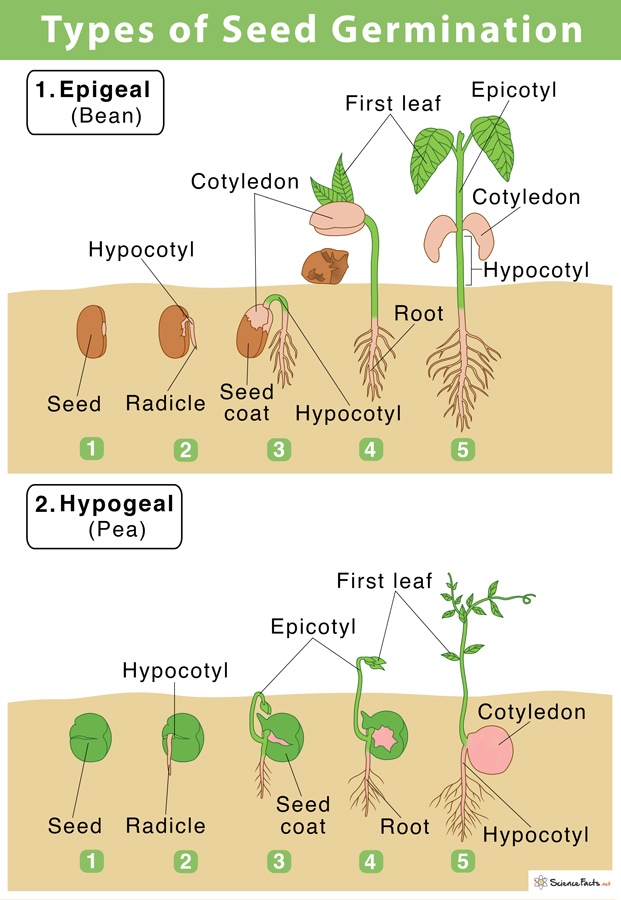Seed Germination
What is Seed Germination
Most plants that we see around us have three essential parts, roots, stems, and leaves. Once they mature, most of them bear flowers. A mango tree flowers during spring to later give rise to mango fruit. Inside the fruit, we find the seed that we discard after eating the fruit. Have you ever noticed a new plant to grow from the seed you have thrown away after eating?
The process through which a new plant develops from its seed is called seed germination.
How do Seeds Germinate: The Process with Steps
Seed germination includes a series of events happening in a sequential order, starting from an inactive seed to the formation of a baby plant:
Stage 1: Imbibition: This is the first step where the seed rapidly absorbs water from the environment causing the seed coat to swell and become soft.
Stage 2: Activation: The absorbed water activates the enzymes present inside the seed that starts the growth phase in the embryo. The seed begins respiration by absorbing oxygen and utilizing the stored food to form proteins necessary for its growth.
Stage 3: Growth (Formation of Root and Shoot): As the rate of respiration increases, the seed coat ruptures to form a radical which later develops into a primary root, while the plumule develops into a shoot. During this period, the enzymatic activity remains at an all-time high.
Stage 4: Morphogenesis (Formation of Seedling): This is the final step of seed germination when the first embryonic leaf or the cotyledon appears. Gradually, tiny leaves sprout from the shoot ends, these are known as foliage leaves. During this initial phase of development the baby plant continues to use the food stored within the seed. Once this phase is complete, it starts synthesizing its own food by photosynthesis.
Types of Germination in Plants
There are two main types of germination found in plants:
Epigeal Germination: Here the cotyledons are found to grow above the soil. This happens due to the rapid elongation of the region between the cotyledons and the radical in the baby plant. This region is called the hypocotyl.
Examples – Bea, Cotton, castor, papaya, onion, and gourd.
Hypogeal Germination: Here the cotyledons are found to grow below the soil. It occurs due to rapid elongation of the region between the plumule and the cotyledons in the baby plant. This region is called the epicotyl.
Examples – Pea, wheat, maize, rice, gram, and groundnut.
Apart from the above two types, a special type of germination called vivipary or viviparous germination is found in mangrove plants. The seeds of such plants cannot germinate in the soil due to high salt and low oxygen concentration in their marshy habitat. So, the embryo starts to grow within the fruit, and while still attached to the parent plant. The hypocotyl elongates, first pushing the radical out of the seed, and then out of the fruit. Gradually, the lower part of the radical becomes thick and swollen which then breaks off the parent plant, forming new roots and establishing directly as a baby plant.
Factors Affecting Seed Germination
Seeds need the right environmental conditions and a favorable internal environment to germinate. Several factors affecting the method of germination are described below:
External or Environmental Factors
1) Water: The presence of sufficient water is important to start the seed’s enzymatic activity and metabolism. As previously described, the water intake inside the seed causes the seed coat to rupture, thus allowing the seedling to emerge from the seed.
2) Temperature: This is a critical factor in germination with each seed requiring a specific temperature range. Generally, the warmer the temperature, the faster is the rate of germination. Most seeds germinate over a wide temperature range from 16°C to 24°C. Depending on the climate, some seeds germinate when the soil is cool (from -2°C to -4°C), while others require a warmer temperature (24°C to 32°C).
3) Oxygen: The respiratory rate in germinating seeds increases in the presence of oxygen. Since respiration forms the main energy source for a metabolically active seed, oxygen becomes a vital factor for germination. A seed devoid of oxygen cannot enter the metabolically active stage and remains inactive or dormant.
4) Light/Darkness: One of the most important factors for a seed to germinate is the presence/absence of light. Seeds that respond to light for germination are called photoblastic. For example, seeds of plants like lettuce and tobacco need light for germination and are called positive photoblastic seeds. In contrast, the seeds of onion and lily germinate only in darkness, being negatively photoblastic.
5) Soil Salinity: High salt concentrations in the soil inhibits water uptake by the seed, making the soil unfit for germination. This causes the seed to become dormant. Frequent watering and the use of organic fertilizers are some ways to reduce soil salinity.
Internal Factors
1) Seed Viability: The presence of growth hormone gibberellin helps the seed to germinate and become a baby plant by shedding the seed coat. An immature embryo will not germinate until it attains complete maturity. A seed can remain viable for germination for a week to many years, depending on the plant species.
2) Dormancy Period: Factors such as the presence of tough and impermeable seed coat, presence of growth inhibitors, and the absence or shortage of food supply can cause a seed to remain in an inactive or dormant state. Here, gibberellin plays an important role in breaking seed dormancy and thus making the seed return to active metabolism.
How Long Does it Take for a Seed to Germinate
As we know, the rate of germination increases by increasing the temperature. A seed usually takes 1 to 2 weeks to germinate in a warm environment. Some seeds, such as rosemary, chili pepper, and mini tomato, may even take up to 3 weeks. In contrast, some others, such as lettuce, are sensitive to high temperatures and need a cooler environment.
-
References
Article was last reviewed on Thursday, February 2, 2023






You have made outstanding worksheet about Seed germinations thanks.
Mrs Gilani (primary school)
great